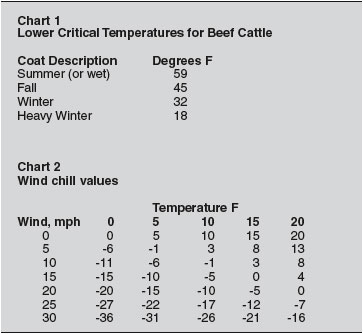Here comes winter, ready or not. For the grazier, winter means dealing with cold temperatures, wind chill, freezing rain and mud. All of these winter-weather related conditions can negatively impact livestock performance and increase the energy requirement of the animal.
Let’s look at winter weather from a livestock perspective to understand what they are facing. All animals have what is termed a thermo neutral zone, that is, a range in temperature where the animal is most comfortable and is not under any temperature stress.
Definition
This is the temperature range that is considered optimum for body maintenance, animal performance and health. The lower boundary of this zone is referred to as the lower critical temperature. Livestock experience cold stress below the LCT.
An increase in the metabolism of the animal in order to maintain body temperature is one method of dealing with cold stress. This requires more energy, either from fat stores or more energy intake in the diet. The general rule of thumb is that energy intake must increase by 1 percent for each degree of cold below the LCT.
The LCT is influenced by such factors as size of the animal, breed, age, housing conditions, hair coat or wool thickness and nutrition. Most graziers utilize a management system where livestock have little or no access to a barn during the winter months so hair coat or wool thickness and nutrition level are the factors we are most concerned with.
Relationship
As hair coat or wool thickness is increased, the LCT decreases. Quite a bit of research and study has been done with beef cattle on this topic. Chart 1 describes the relationship between hair coat thickness and the LCT.
The LCT for goats is generally considered as 32 F, and for sheep the LCT is 50 F if freshly shorn or 28 F with 2.5 inches of fleece. Note that once the coat is wet, regardless of how heavy it is, the lower critical temperature increases to 59 F. This is because hair coats lose their insulating ability when wet. This would apply to cattle, horses and goats, but not sheep, since wool has the ability to shed water and maintain its insulating properties.
Dry, cold weather is easier on cattle, horses and goats than cool, wet weather. Wind speed produces wind chill and can further increase energy requirements for livestock when those values are below the LCT. Chart 2 provides wind chill values at various wind speeds when combined with a range of ambient temperatures.
Effects of mud
Late fall and winter rain often means muddy conditions. As in the case with rain, mud reduces the insulating ability of the hair coat, leading to a need for increased energy. The relationship between mud and its effect on energy requirements is not as well defined as the temperature charts, but depending upon the depth of the mud and how much matting of the hair coat it causes, energy requirements could increase 7 percent to 30 percent over dry conditions.
In addition, there is research that suggests that mud may also be associated with decreased feed intake. The National Research Council (1981) says mud 4 to 8 inches deep can reduce feed intake of animals by 5 percent to 15 percent, and that mud 12 to 24 inches deep can decrease feed intake from 15 to 30 percent.
The University of Nebraska (1991) looked at the relationship between mud depth and potential loss of gain at ambient air temperatures of 21 F to 39 F. Loss of gain ranged from 7 percent for mud dewclaw deep to 35 percent for mud that was belly deep. Thus the worst situation for livestock is cold stress combined with mud.
Options
Graziers have several management options to help livestock cope with winter weather stresses, including:
• Provide windbreak protection to reduce the effects of wind chill on energy requirements.
• Increase access to better quality forage. Livestock can increase intake to some extent under cold conditions and if forage is of good quality, then energy intake is also increased.
• If forage is poor quality, livestock may not be able to increase intake. In this case, the options are to either provide a supplemental energy source such as corn grain, or grind the forage to increase the digestibility and the intake level.
• Move livestock out of muddy conditions or take steps to reduce the mud by utilizing a feeding pad, or decreasing the stocking density in a pasture paddock.
STAY INFORMED. SIGN UP!
Up-to-date agriculture news in your inbox!













